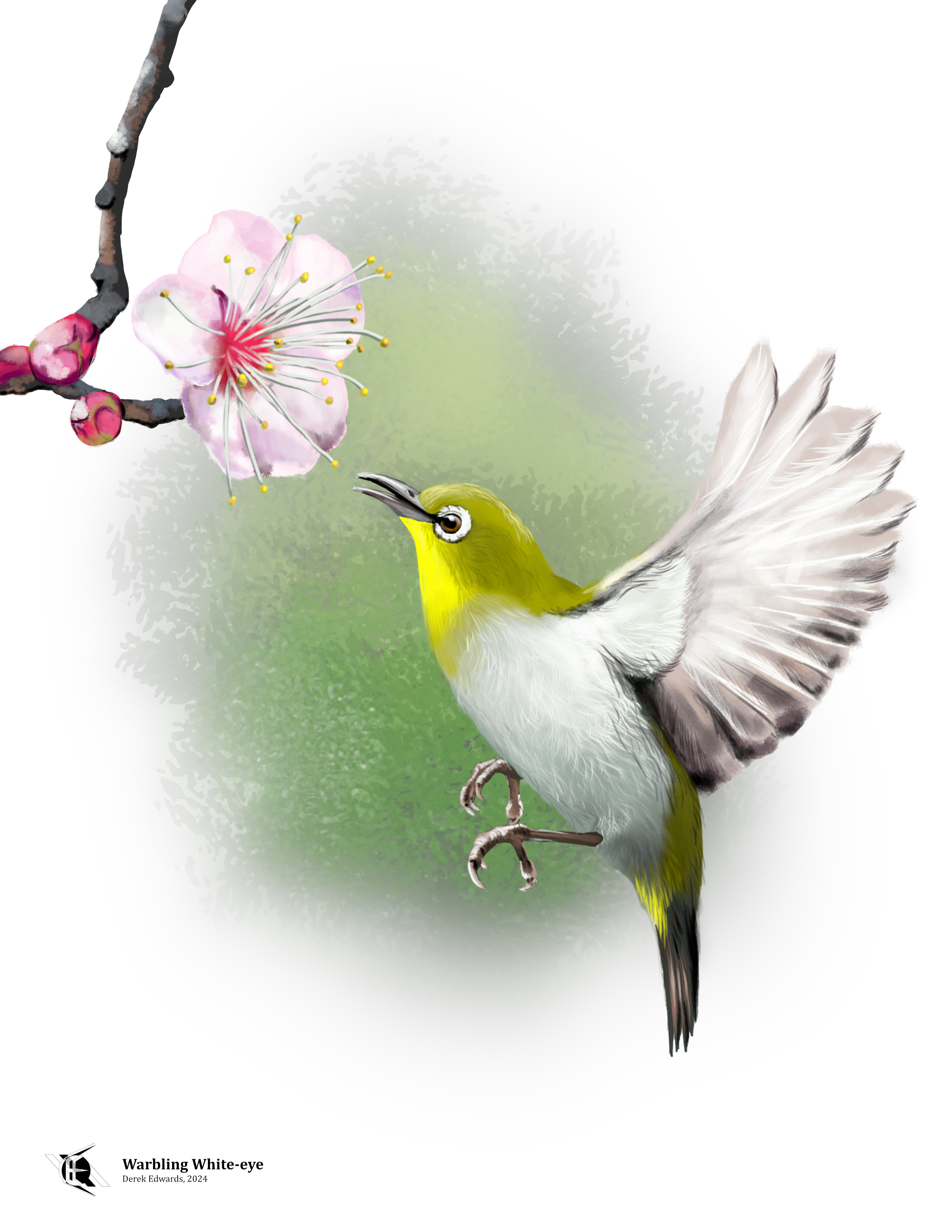
Running Commentary 4/15/2024
Hello,
I've spotted another lifer, rather unexpectedly, while I wasn't even looking for birds: a meadowlark, which I heard, then saw, in an airfield. Michigan has both eastern and western meadowlarks, and while I'd expect a western in such a human environment, its song was that of an eastern. I'll be drawing one next.
Anyway...
Watching...

The Bad Batch
- So, once again we have it laid out that what's special about Omega: she isn't Force-sensitive necessarily, but something about her biology is the key to making Force-sensitive clones.
- I honestly expected Rampart to have been quietly executed after we saw him last. I guess he didn't merit that.
- The labor camp where Rampart is held is not the same one that Jyn Erso was held in in Rogue One, although they did look similar
- The titular action scene with the dueling HAVw A9 Juggernauts and the later chase on the cliff roads by the gunships is the best action scene in this season so far. Just really great stuff.
- There's only three episodes left, and the Batch still don't know where Tantiss is. Rampart doesn't know, but maybe he'll be able to help them. Again, it seems to me that Crosshair should be able to find his way back, since he piloted away in the first place.
Playing...
Warframe
Alright, I think the changes to Dante are more-or-less settled. I never did figure out how to do the huge room nuke that he was supposedly able to do for the first few days after release. I took the video below back when I first got Dante leveled, before the big nerf, but, having played him in some high-level content this past week, I think he plays mostly the same way.
Dante is quite a good 'frame for a support role, which makes him somewhat difficult to fully demonstrate in the Simulacrum. His powers are a little complicated; his 4th ability can be any of four things depending on which combination of his 2 or 3 you cast first. There's a little symbol that appears in the side of the HUD to remind you what the 4 will cast, which is handy. His 2 is a squad heal, which builds overguard, and his 3 is a group attack, dealing Slash damage. 2, 2, 4 will provide the squad significant healing and lots of overguard, while 3, 3, 4 will deliver significant slash damage to every enemy in line-of-sight. (This was a big point of the nerfs and subsequent buffs made to Dante. I will say that line-of-sight seems to work well at present, with his 4 hitting most enemies in a room if you're well positioned.) 2, 3, 4 is a squad damage buff, while 3, 2, 4 is a crowd debuff that makes enemies more vulnerable to status effects. His 1 is an exalted tome weapon, which is able to equip all the tome mods you want. At the level you're at when Dante becomes farmable, I can't say it's a great damage dealer, and given that Dante is already really energy hungry, I can't say it's really that worth casting in my eyes.
Dante can deal damage respectably, but several other 'frames can do better than him at that. What he's good for is keeping the squad alive, while still being able to deal damage. His biggest weakness is that he doesn't have much in his kit to take down high-priority targets. A big eximus unit is going to be trouble if he doesn't have good single-target weapons equipped. And, again, he's very late game, so by the time a player gets him, it's unlikely that they truly need him specifically to fill some hole in their roster. But Dante's still one of the better 'frames in the game, reasonably straightforward to play, despite his many powers, and engaging enough. And he's the best looking 'frame we've gotten in a while.

Bird of the Week
This week we have a nice springtime composition. The Warbling White-eye is a small green songbird found throughout the islands of Pacific Asia, one of over 100 species of white-eye found throughout Asia, Africa, and Australia. It is one of only three white-eyes found in Japan, and of these it is by far the most commonly found in human landscapes. In fact, you might often see it said that the warbling white-eye is also called the Japanese white-eye, but that is not quite true. There was a species, Zosterops japonicus, called the Japanese white-eye, which had a subspecies called Swinhoe's white-eye (Z. japonicus simplex). But a few years ago genetic studies indicated that the Japanese white-eye was not the same thing as Swinhoe's white-eye (which was made its own species, Z. simplex), and that furthermore it was the same thing as the mountain white-eye (Z. montanus), a bird found in the Phillipines. Coming out of that, Z. japonicus absorbed Z. montanus and expelled Z. simplex, and the resultant species was given the common name warbling white-eye.1 Species limits among the vast Zosterops genus are still being worked out by ornithological taxonomists.
Warbling white-eyes are strongly associated with flowering and fruiting trees. They feed on fruit and nectar, and also on the small insects found inside blossoms. It is an important spreader of seeds, both in Japan and in Hawai'i, where it has been introduced. There, it serves to spread the invasive firetree though open-canopy forests.2 They flock with other white-eyes as well as with other sorts of songbirds, forming mated pairs in the winter and beginning to build nests in late February.
As it is a common sight to the Japanese people, it is unsurprising that the warbling white-eye is a featured creature in Japanese culture. One particularly interesting example is in its connection to Tokyo's famous Goshiki Fudo temples. The story goes that the 17th Century shogun Tokugawa Ieyasu, wishing to provide mystical protection to what was then the city of Edo, a new capital built to replace Kyoto, ordered the construction of five temples dedicated to the "unmovable" god Fudo, each housing statues of Fudo bearing eyes painted a different color. In the north, the idol had black eyes, in the south, red eyes, in the east, blue eyes, in the west, white eyes, and in the center of Edo, the idol had yellow eyes. These five temples were arranged in a pattern of produce a circle of protection around Edo. This story, though, is not the actual story of the temples' construction but rather a story dating from a late 19th Century novel (though this likely adapted earlier folklore), whose popularity prompted the priests of some Tokyo temples to re-brand as part of the Goshiki Fudo, including two different temples that both claim to house Tokugawa's yellow-eyed Fudo. Only the black-eyed and white-eyed Fudo temples actually date back to the days of Tokugawa.3 The white-eyed temple ultimately owes its name to the warbling white-eye, which is the namesake of the Mejiro neighborhood in which the temple stands. Mejiro, Tokyo is today mostly a college town, the area dominated by Gakushuin University, which is, from what I can tell, roughly the Japanese equivalent of Harvard, a prestigious private school specializing in providing humanities education to the upper class. Overall, more the sort of place to be named after a garden bird than a fierce warrior god, anyway.
(A note for fans of the hit FX series Shogun, which I have not seen: Tokugawa was the inspiration for the titular shogun featured in the book the show is based on.)
As I mentioned, science knows the warbling white-eye as Zosterops japonica. The specific epithet simply means "of Japan"; the English name "Japan" is the result of an interlinguistic game of telephone, what you get when the English ask the Dutch what the Portuguese said the Malaysians told them the Chinese called the chain of islands off their eastern coast. (The Chinese called them "jih pun", or "where the sun comes from", which is also the meaning of the Japanese name for Japan, 日本, which can be pronounced "Nippon" or "Nihon")4 The generic epithet comes from the Greek for "girdled eye"5, a reference to the namesake white band of feathers surrounding the eyes of most (but not all) species in the genus.
- Lim, Bryan T. M., Keren R. Sadanandan, Caroline Dingle, Yu Yan Leung, Dewi M. Prawiradilaga, Mohammad Irham, Hidayat Ashari, Jessica G.H. Lee, and Frank E. Rheindt. “Molecular Evidence Suggests Radical Revision of Species Limits in the Great Speciator White-eye Genus Zosterops.” Journal of Ornithology (2004. Print) 160, no. 1 (July 23, 2018): 1–16. https://doi.org/10.1007/s10336-018-1583-7.
- Vitousek, Peter M., Lawrence R. Walker, Louis D. Whiteaker, Dieter Mueller‐Dombois, and Pamela A. Matson. “Biological Invasion by Myrica Faya Alters Ecosystem Development in Hawaii.” Science 238, no. 4828 (November 6, 1987): 802–4. https://doi.org/10.1126/science.238.4828.802.
- Zub, Jim. "Circle of Protection Tokyo! The Goshiki Fudo." Wayward, Volume 2:Ties That Bind. (2015) Image Comics, p. 125
- Etymonline. “Japan,” n.d. https://www.etymonline.com/word/Japan#etymonline_v_1664.
- Jobling, J. A. (editor). The Key to Scientific Names in Birds of the World (S. M. Billerman et al. editors), Cornell Laboratory of Ornithology, Ithaca.
Curation Links
The Placebo Effect’s Evil Twin | Michael H. Bernstein, Quillette
The nocebo effect (the name coming from the Latin for “harm”) is a phenomenon wherein someone who expects to feel sick begins to feel sick, even though whatever they’re experiencing isn’t actually physically harmful. The convulsions experienced by patients undergoing Mesmerization were an example, as may be the mysterious Havana syndrome.
Poison Control | Brenna Farrell, et al, Radiolab
[AUDIO] "When reporter Brenna Farrell was a new mom, her son gave her and her husband a scare—prompting them to call Poison Control. For Brenna, the experience was so odd—and oddly comforting—that she decided to dive into the birth story of this invisible network of poison experts, and try to understand the evolving relationship we humans have with our poisonous planet. As we learn about how poison control has changed over the years, we end up wondering what a place devoted to data and human connection can tell us about ourselves in this cultural moment of anxiety and information-overload."
Visiting Glashütte, the small town in East Germany that has mastered time | Ross Anderson, The Spectator
A visit to a site of old-style mechanical watchmaking, not focused on building a luxury brand but on building precision mechanisms. The industry in Glashütte has survived many wars, and, almost as devastating to the watchmaker, the invention of solid-state quartz movements.
The Peaceful Circle—Year in a Wild Marsh | Leath Tonino, The Sun Magazine
[FICTION] Viewers of footage of a marsh and the creatures that live there weigh in with their thoughts on what they’ve seen.
See the full archive of curations on Notion






Member Commentary